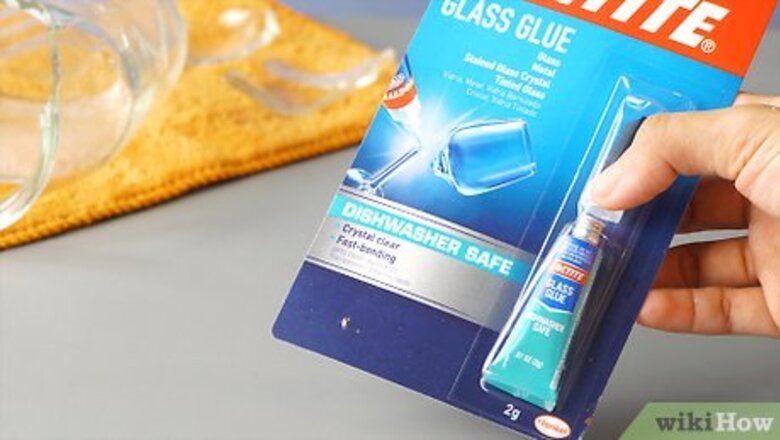
views
Repair a Fracture

Select a glue. You'll need a specialized glue made to bond with glass, or the glass will come apart again as soon as it is cleaned. Silicone based adhesives are transparent and strong once dry, but can be toxic. Aquarium glues fall under this category. Ultraviolet (UV) curing acrylic resins are excellent for repairing clear glass fragments that fit snugly together. They require exposure to sunlight or a UV lamp to set. Opaque or colored glass may block some of the UV light, causing a weaker bond. If you are repairing an object that will be exposed to water, make sure the glue is waterproof. Most silicone adhesives and some UV resins are waterproof. If you are repairing an object that will come into contact with food or drink, check that the glue used is made for this purpose. Some adhesives are toxic even when dry.

Clean both pieces with soap and water. After cleaning, wipe each piece dry thoroughly with a clean cloth. The pieces will bond best if they are clean, dry, and oil-free. Wear latex gloves while preparing and gluing the surfaces. This will prevent oil from your hands from rubbing off on the glass, and protect you from toxic or messy adhesives. Difficult stains can be scrubbed off using steel wool.

Apply glue along one of the broken edges. You only need a small amount, but make sure the entire broken edge is covered. You only need to apply glue to one of the broken pieces.

Press the two pieces together. Ensure the broken surfaces are aligned and hold in place for at least one minute.

Allow the glue to set. This will take somewhere between a few minutes and 24 hours depending on the type and brand of glue. Even once it seems firm, avoid applying significant force for 24 hours. UV curing adhesives require exposure to ultraviolet light. A few minutes in direct, bright sunlight or under a UV lamp should harden the glue. Allow more time for opaque glass or less intense sunlight. Silicone based glues require several hours at least to set. They do not require sunlight and will set in most weather conditions (5%–95% humidity; 40º–100ºF=5º-40ºC). For large flat pieces of glass, fix them in place with a glass clamp or another clamp specialized for holding fragile objects. Avoid cracking the glass through over-tightening.
Shave away any excess glue with a razor blade. Check in on the glass before it's done setting. Excess glue may have oozed out of the joint and begun to dry. Carefully shave away this excess glue with a razor blade and wipe the surrounding area clean. Both UV and silicone glues will dry completely clear, so the fracture should be well concealed. EXPERT TIP Douglass Brown Douglass Brown Glassblowing Expert Douglass Brown is a Glassblowing Expert based in Half Moon Bay, California. He has over 25 years of experience as a glass artist, and is the owner and operator of 2 glass blowing studios in the San Francisco Bay Area, Half Moon Bay Art Glass and Mare Island Art Glass. Douglass believes in sharing hot glass experiences with anyone who wants to learn about the processes of blowing and sculpting glass. When not teaching, Douglass creates glass art that is a mix of his takes on nature and functional glassware. He has also created the Glass Troubadours, which is a mobile glass blowing studio that hosts parties, events, and visits craft shows. Douglass Brown Douglass Brown Glassblowing Expert It is not advisable to reuse broken glass. You might be able to glue it back together, but the glass loses its original qualities. It will not be as strong and stable as before. For safety reasons, avoid using broken glass for its original purpose.
Decorate Glass

Decide on materials and glue. You could decorate a glass jar with fabric or paper cutouts, or make a 3D mosaic by placing ceramic or glass tiles over a flower vase. Each combination of two materials can only be bonded by specific glues. Browse your hardware store or art supply store and read the glue labels to see which one is suitable for the materials you chose. A glue that dries clear is preferable for most art projects.

Prepare your materials. A few simple steps will quicken the decorating process and ensure that the glass bonds strongly. Wash the glass thoroughly with soap and water. Dry the glass with a clean paper towel. Empty some glue into a plastic container. This will make it easy to apply with a paintbrush, and cause it to dry slightly for a useful tacky consistency.
Paint a thin layer of glue over the object. Cover any areas you intend to decorate. Wipe off any excess blobs and wait for it to dry. The setting time for the glue varies depending on the type of glue used. In most cases 5-10 minutes should be enough. EXPERT TIP Bicycle Glass Bicycle Glass Glassblowing Experts Bicycle Glass Co. was founded in 2016 by David Royce and Michael Boyd, two professional glass experts. Bicycle Glass is primarily a lighting company, committed to quality, sustainability, and affordability. All Bicycle Glass products are made of high-quality, recycled glass and are hand-blown by a dedicated team of artisans. The studio is committed to reducing its carbon footprint by conserving energy in all of its production. Using renewable wind energy to offset all electricity usage, the studio is actively working toward the goal of carbon neutrality. Bicycle Glass believes that high-quality, handmade glass products should be within reach for everyone. Bicycle Glass Bicycle Glass Glassblowing Experts Choosing the perfect type of glue can make all the difference in your project. Different glues have different strengths, clarity, and drying times, so choose the one that will work best for you. Do you need a strong bond? Or is clarity after drying your top priority?

Apply a second layer of glue to a small area. Once the first coat has dried, adding a small amount of glue to an area will make it wet and tacky, preventing your decorations from slipping. Wait another 5-10 minutes for this to take effect.

Attach your decorations to the prepared area. If they slide off, wait for the glue to dry a little more and try again. Apply, wait, and decorate each area in turn. Feel free to apply glue to a new area while you're still decorating the previous one.

Add a last layer of glue over your decorations to seal them in. Let dry.

Spray with a sealant to ensure durability and water resistance. Let dry for 15 minutes.

Wipe off excess glue and let dry. Allow the glue to stand 24 hours before handling the object roughly, then enjoy your new decoration!

Finished!
















Comments
0 comment